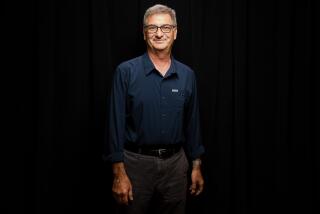Seattle’s Bullitt Center is flush with green features, including toilets
- Share via
Reporting from SEATTLE — Most building tours do not highlight the sewage system. They don’t encourage visitors to flush the toilets. There is no bragging about the path traveled by what are delicately known as biosolids.
But then, most buildings aren’t the Bullitt Center, a six-story monument to all things environmentally correct. And these aren’t just any toilets.
“This is our composting toilet system,” Bullitt Center spokesman Brad Kahn said proudly as he showed off the bright blue, high-tech bins in the bowels of the building Tuesday. “We believe this is the world’s only … six-story composting system in a Class A office building.” Class A buildings are considered the highest quality with state-of-the-art systems.
Ever since the Bullitt Center broke ground four years ago, its owners have been boasting of its deep green credentials. This week, they finally have evidence that the sleek structure is probably the most environmentally correct building of its type in the world.
During a three-day conference that begins here Wednesday, the International Living Future Institute will announce that the $32.5-million office building meets standards it says are stricter than those administered by the U.S. Green Building Council, best known for its Leadership in Energy and Environmental Design, or LEED, rating system.
Structures that meet the institute’s Living Building Challenge standards — the Bullitt Center the biggest among them — are graded for at least a year on their actual performance in areas including energy consumption and water use.
Jason McLennan, chief executive of the institute, calls the Bullitt Center “revolutionary in many ways.” Not only does it meet exacting environmental standards, he said, but it also “has to get normal market rental rates. It has to compete in the market.”
“Instead of minimizing environmental damage, we’re trying to define what good looks like,” McLennan said. The Bullitt building “is a pretty big achievement. It shows how close we are to a fossil-fuel-free world.... People said it’s too hard, too expensive. It’s nice to prove these people wrong.”
Among the building’s highlights are 14,303 square feet of solar panels that extend beyond the roofline. There also is an automated window system that is controlled by a computer, which is fed information from a weather system on the roof. When the weather is warm, the windows automatically open at night to cool the building when the sun is down. Window coverings on the building’s exterior are raised and lowered to keep glare off tenants’ computer screens.
In the average Seattle office building, Kahn said, 30% to 40% of the energy used is for heating and cooling. In comparison, the Bullitt building uses only 2% to 3% of its energy for heating and cooling. Windows are triple-paned for greater insulation.
Permanent workstations are all within 30 feet of a window, and the sun — yes, even in gloomy Seattle — is the main source of light.
As a result, the building far exceeded its goal of zero net energy use, generating 60% more electricity from its solar panels than it used in its first full year of operation — even here in what Bullitt Foundation President Denis Hayes called “the cloudiest major city in the Lower 48 states.”
“It is by far the most energy-efficient office building in the United States, by almost a factor of two, and one of the most efficient any place in the world,” said Hayes, cofounder of the original Earth Day. The Bullitt Foundation, which financed the building, is based in Seattle and focuses on environmental advocacy in the Pacific Northwest.
Once it is fully approved by public health officials, the Bullitt Center will be the first major office building in the country to capture rainwater from the roof, purify it and use it for all purposes including drinking.
The building is equipped with a 52,000-gallon cistern, which Bullitt officials say is a 104-day supply, enough to get tenants through the dry summer season.
“We’re doing this because some day, as a region, we’ll have to think about where our water comes from,” Kahn said. “That day is getting closer. We wanted to drive that conversation.”
Oh, and about the composting toilets?
Every flush mixes between one tablespoon and one cup of water with biodegradable soap into a foam that helps waste make its way through the system more easily. Once that waste enters the blue bins, it hits a series of ramps. A hand crank turns the material, much like a home compost system for a backyard garden.
After 18 months, the compost goes through the King County secondary treatment facility. It is later bagged and sold in garden supply stores as GroCo compost.
“And because no one wants a Class A office building that smells like an outhouse, we’re constantly pulling air down through the toilets,” Kahn said. “If you sit on a toilet, you can feel a little breeze.
“It’s refreshing.”
Twitter: @marialaganga
More to Read
Sign up for Essential California
The most important California stories and recommendations in your inbox every morning.
You may occasionally receive promotional content from the Los Angeles Times.











